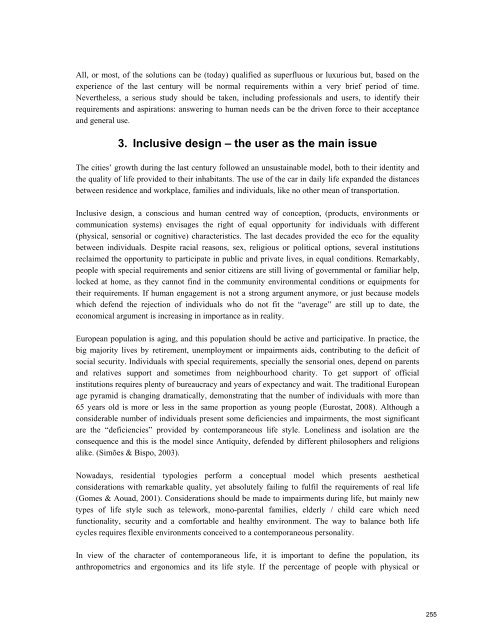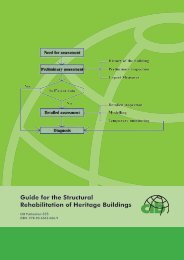CIB W116âSmart and Sustainable Built Environments - Test Input
CIB W116âSmart and Sustainable Built Environments - Test Input
CIB W116âSmart and Sustainable Built Environments - Test Input
You also want an ePaper? Increase the reach of your titles
YUMPU automatically turns print PDFs into web optimized ePapers that Google loves.
All, or most, of the solutions can be (today) qualified as superfluous or luxurious but, based on the<br />
experience of the last century will be normal requirements within a very brief period of time.<br />
Nevertheless, a serious study should be taken, including professionals <strong>and</strong> users, to identify their<br />
requirements <strong>and</strong> aspirations: answering to human needs can be the driven force to their acceptance<br />
<strong>and</strong> general use.<br />
3. Inclusive design – the user as the main issue<br />
The cities’ growth during the last century followed an unsustainable model, both to their identity <strong>and</strong><br />
the quality of life provided to their inhabitants. The use of the car in daily life exp<strong>and</strong>ed the distances<br />
between residence <strong>and</strong> workplace, families <strong>and</strong> individuals, like no other mean of transportation.<br />
Inclusive design, a conscious <strong>and</strong> human centred way of conception, (products, environments or<br />
communication systems) envisages the right of equal opportunity for individuals with different<br />
(physical, sensorial or cognitive) characteristics. The last decades provided the eco for the equality<br />
between individuals. Despite racial reasons, sex, religious or political options, several institutions<br />
reclaimed the opportunity to participate in public <strong>and</strong> private lives, in equal conditions. Remarkably,<br />
people with special requirements <strong>and</strong> senior citizens are still living of governmental or familiar help,<br />
locked at home, as they cannot find in the community environmental conditions or equipments for<br />
their requirements. If human engagement is not a strong argument anymore, or just because models<br />
which defend the rejection of individuals who do not fit the “average” are still up to date, the<br />
economical argument is increasing in importance as in reality.<br />
European population is aging, <strong>and</strong> this population should be active <strong>and</strong> participative. In practice, the<br />
big majority lives by retirement, unemployment or impairments aids, contributing to the deficit of<br />
social security. Individuals with special requirements, specially the sensorial ones, depend on parents<br />
<strong>and</strong> relatives support <strong>and</strong> sometimes from neighbourhood charity. To get support of official<br />
institutions requires plenty of bureaucracy <strong>and</strong> years of expectancy <strong>and</strong> wait. The traditional European<br />
age pyramid is changing dramatically, demonstrating that the number of individuals with more than<br />
65 years old is more or less in the same proportion as young people (Eurostat, 2008). Although a<br />
considerable number of individuals present some deficiencies <strong>and</strong> impairments, the most significant<br />
are the “deficiencies” provided by contemporaneous life style. Loneliness <strong>and</strong> isolation are the<br />
consequence <strong>and</strong> this is the model since Antiquity, defended by different philosophers <strong>and</strong> religions<br />
alike. (Simões & Bispo, 2003).<br />
Nowadays, residential typologies perform a conceptual model which presents aesthetical<br />
considerations with remarkable quality, yet absolutely failing to fulfil the requirements of real life<br />
(Gomes & Aouad, 2001). Considerations should be made to impairments during life, but mainly new<br />
types of life style such as telework, mono-parental families, elderly / child care which need<br />
functionality, security <strong>and</strong> a comfortable <strong>and</strong> healthy environment. The way to balance both life<br />
cycles requires flexible environments conceived to a contemporaneous personality.<br />
In view of the character of contemporaneous life, it is important to define the population, its<br />
anthropometrics <strong>and</strong> ergonomics <strong>and</strong> its life style. If the percentage of people with physical or<br />
255

















